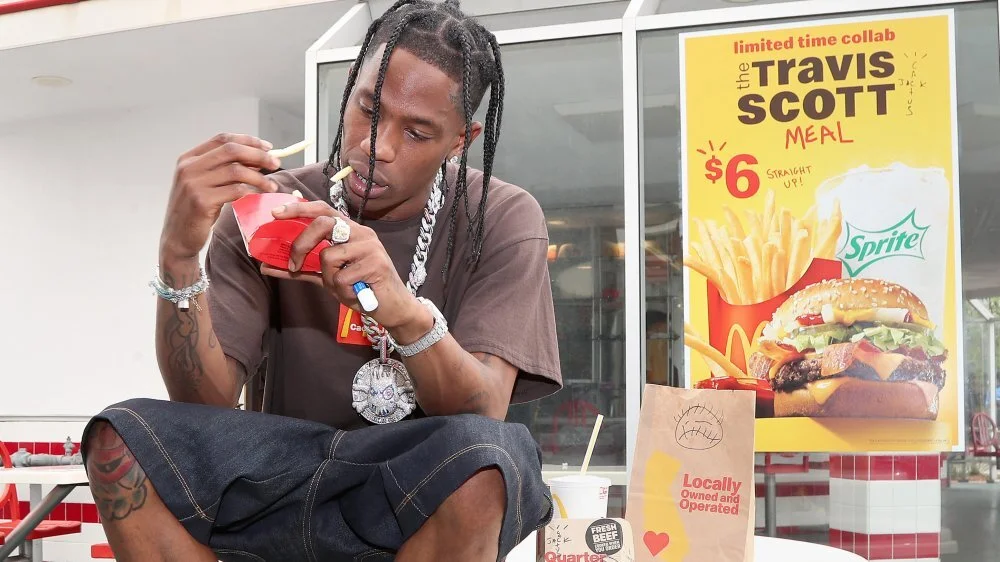Fashion's Obsession With Unconventional Collaborations
The fashion industry has increasingly welcomed odd and surprising collaborations in the past years, which have successfully attracted customers' attention and increased overall engagement with brands. These collabs have allowed brands to attract a new clientele as well as spread brand awareness. Take, for example, Travis Scott's recent collab with McDonald's. Since when is McDonald's fashionable?? Despite a somewhat unconventional fashion collab, the collection sold out, and Mcdonalds saw 5x more engagement on their Instagram when posting about the collab. This seems to be a successful business model.
Customers who went to McDonald’s were able to buy the Travis $6 meal deal, including a quarter pounder with cheese and bacon, medium French fries, bbq sauce, and a sprite. Travis' go-to McDonald’s order. Nothing particularly spectacular. However, the meal deal came with a limited edition merch drop, including t-shirts, jackets, hoodies, and even homeware items like a McNuggets pillow. All the items are sold out and are currently being resold for thousands on websites like Grailed.
It’s interesting to think about customer behavior and, ultimately, the value of limited edition collabs for brands. In McDonald's’ case, they gained new customers, specifically Gen Z, and new brand credibility. In light of the success that Mcdonalds saw with the Travis collab, McDonald’s just launched a new collab with J Balvin in an attempt to reciprocate the same success. McDonald's is recognizing that Gen Z is interested in seeing different brands work together that the key to growing their business and increasing revenues is through these types of creative ventures.
Although fashion collabs, not just McDonald’s, have been widely successful, there is still a limit to what a customer will accept. Fundamentally, the two collaborating brands need to share the same values and present some story to the customer. The notion of getting a celebrity to slap their name on a product doesn't suffice to secure a successful collab. For example, Travis has a strong connection to McDonald’s because he remembers eating it all the time as a kid. Equally, by creating the 6 dollar meal deal, he let his fans into his life and shared a unique/personal detail of who he is as a person. The hoodies and advertisements themselves tried to engage the customer by using the slogan "What's up the world- yeah, You! I'm Travis Scott. This is my McDonald's order."
It appears that collabs are not about finding two brands with similar aesthetics but rather radically different aesthetics and, through that, engaging new customers. The success of collabs is seen across the industry. We must only look to Virgil Abloh, who is notorious for countless collabs with brands like Ikea or Evian—brands one wouldn't immediately associate with high fashion.
Producing capsule collections and having limited edition drops exponentially increases the Hype around a product. The customer feels that if they don't buy it now, they will never have it as there is only so much available stock. For example, one of Travis' McDonald's rugs is retailing for 2500 dollars on Grailed right now. That's only because it can't be found anywhere else and will never be sold again. Beyond this, we can look at previous success models such as the Moncler Genius launch, which features limited-edition drops and collabs with designers like Raf Simmons or Simone Rocha. This business model has proved extremely successful for Moncler because customers feel the need to buy it now or lose out. It's as if customers have fashion FOMO.
Other interesting collabs include Hm and Versace, Crocs and Christopher Kane, Supreme—which puts its name on pretty much anything: a brick, MetroCard, calculators—Juicy Couture and Vetements, World food program and Balenciaga. The one thing they all have in common? They were so successful that each collection sold out. Ultimately, it will be interesting to see what new collabs will appear in the future and how the business model of unconventional collabs will continue to be implemented throughout the industry.
Image via
Featured image via







